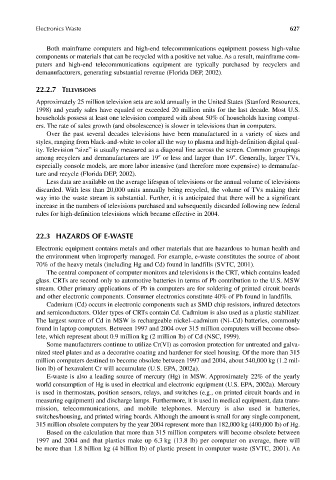Page 656 - Materials Chemistry, Second Edition
P. 656
CAT3525_C22.qxd 1/27/2005 1:00 PM Page 627
Electronics Waste 627
Both mainframe computers and high-end telecommunications equipment possess high-value
components or materials that can be recycled with a positive net value. As a result, mainframe com-
puters and high-end telecommunications equipment are typically purchased by recyclers and
demanufacturers, generating substantial revenue (Florida DEP, 2002).
22.2.7 TELEVISIONS
Approximately 25 million television sets are sold annually in the United States (Stanford Resources,
1998) and yearly sales have equaled or exceeded 20 million units for the last decade. Most U.S.
households possess at least one television compared with about 50% of households having comput-
ers. The rate of sales growth (and obsolescence) is slower in televisions than in computers.
Over the past several decades televisions have been manufactured in a variety of sizes and
styles, ranging from black-and-white to color all the way to plasma and high-definition digital qual-
ity. Television “size” is usually measured as a diagonal line across the screen. Common groupings
among recyclers and demanufacturers are 19 or less and larger than 19 . Generally, larger TVs,
especially console models, are more labor intensive (and therefore more expensive) to demanufac-
ture and recycle (Florida DEP, 2002).
Less data are available on the average lifespan of televisions or the annual volume of televisions
discarded. With less than 20,000 units annually being recycled, the volume of TVs making their
way into the waste stream is substantial. Further, it is anticipated that there will be a significant
increase in the numbers of televisions purchased and subsequently discarded following new federal
rules for high-definition televisions which became effective in 2004.
22.3 HAZARDS OF E-WASTE
Electronic equipment contains metals and other materials that are hazardous to human health and
the environment when improperly managed. For example, e-waste constitutes the source of about
70% of the heavy metals (including Hg and Cd) found in landfills (SVTC, 2001).
The central component of computer monitors and televisions is the CRT, which contains leaded
glass. CRTs are second only to automotive batteries in terms of Pb contribution to the U.S. MSW
stream. Other primary applications of Pb in computers are for soldering of printed circuit boards
and other electronic components. Consumer electronics constitute 40% of Pb found in landfills.
Cadmium (Cd) occurs in electronic components such as SMD chip resistors, infrared detectors
and semiconductors. Older types of CRTs contain Cd. Cadmium is also used as a plastic stabilizer.
The largest source of Cd in MSW is rechargeable nickel–cadmium (Ni–Cd) batteries, commonly
found in laptop computers. Between 1997 and 2004 over 315 million computers will become obso-
lete, which represent about 0.9 million kg (2 million lb) of Cd (NSC, 1999).
Some manufacturers continue to utilize Cr(VI) as corrosion protection for untreated and galva-
nized steel plates and as a decorative coating and hardener for steel housing. Of the more than 315
million computers destined to become obsolete between 1997 and 2004, about 540,000 kg (1.2 mil-
lion lb) of hexavalent Cr will accumulate (U.S. EPA, 2002a).
E-waste is also a leading source of mercury (Hg) in MSW. Approximately 22% of the yearly
world consumption of Hg is used in electrical and electronic equipment (U.S. EPA, 2002a). Mercury
is used in thermostats, position sensors, relays, and switches (e.g., on printed circuit boards and in
measuring equipment) and discharge lamps. Furthermore, it is used in medical equipment, data trans-
mission, telecommunications, and mobile telephones. Mercury is also used in batteries,
switches/housing, and printed wiring boards. Although the amount is small for any single component,
315 million obsolete computers by the year 2004 represent more than 182,000 kg (400,000 lb) of Hg.
Based on the calculation that more than 315 million computers will become obsolete between
1997 and 2004 and that plastics make up 6.3 kg (13.8 lb) per computer on average, there will
be more than 1.8 billion kg (4 billion lb) of plastic present in computer waste (SVTC, 2001). An

